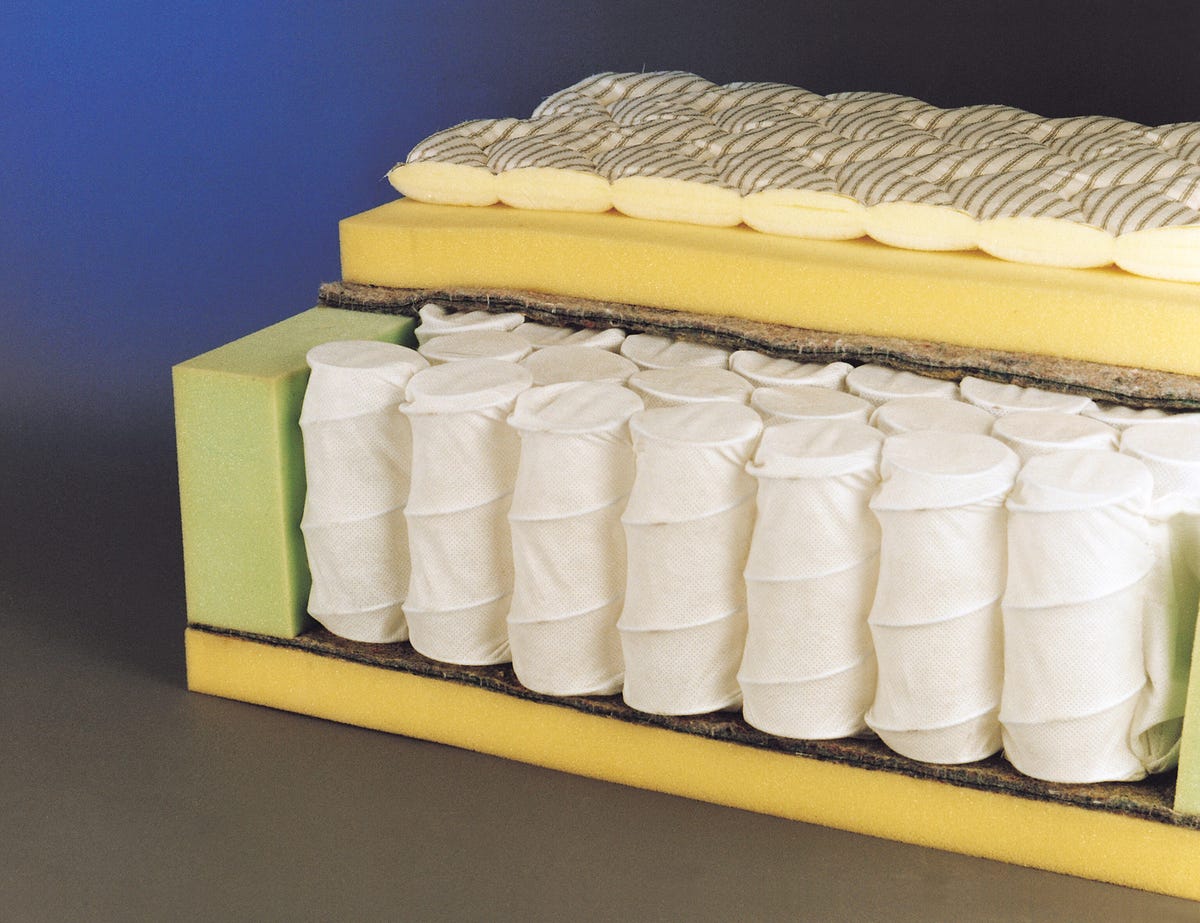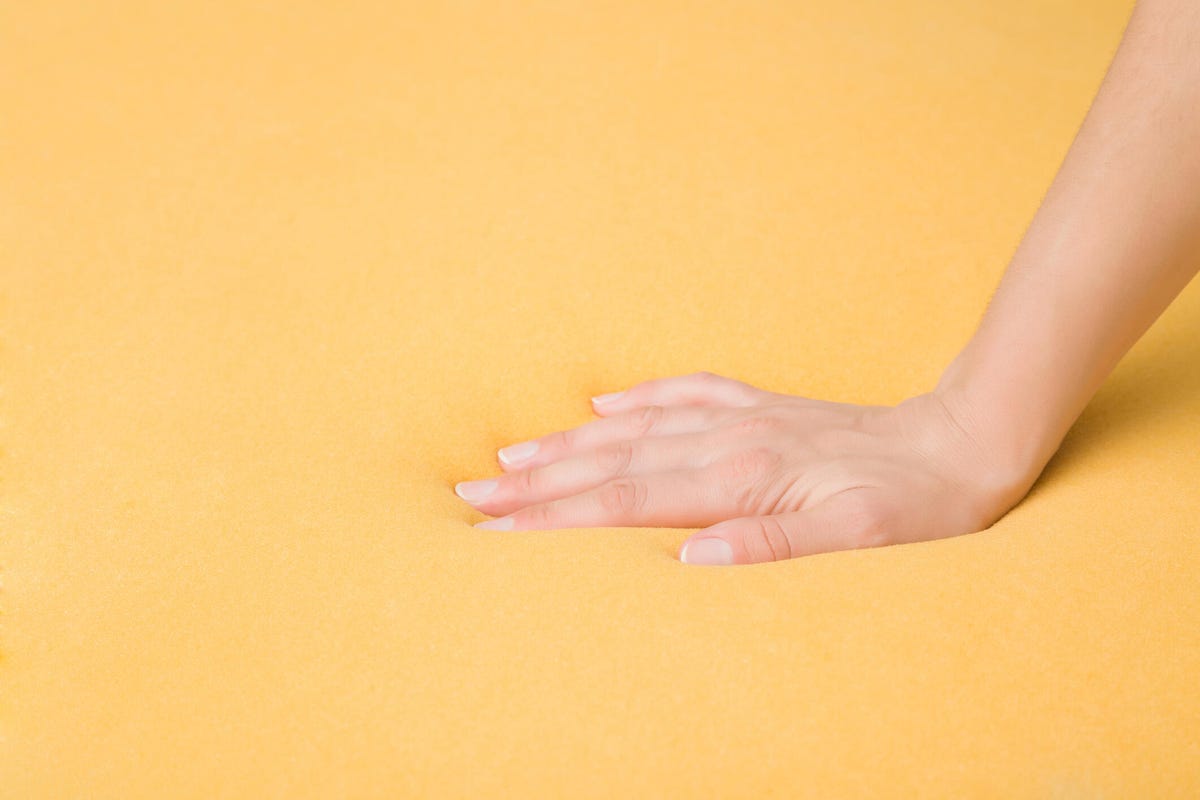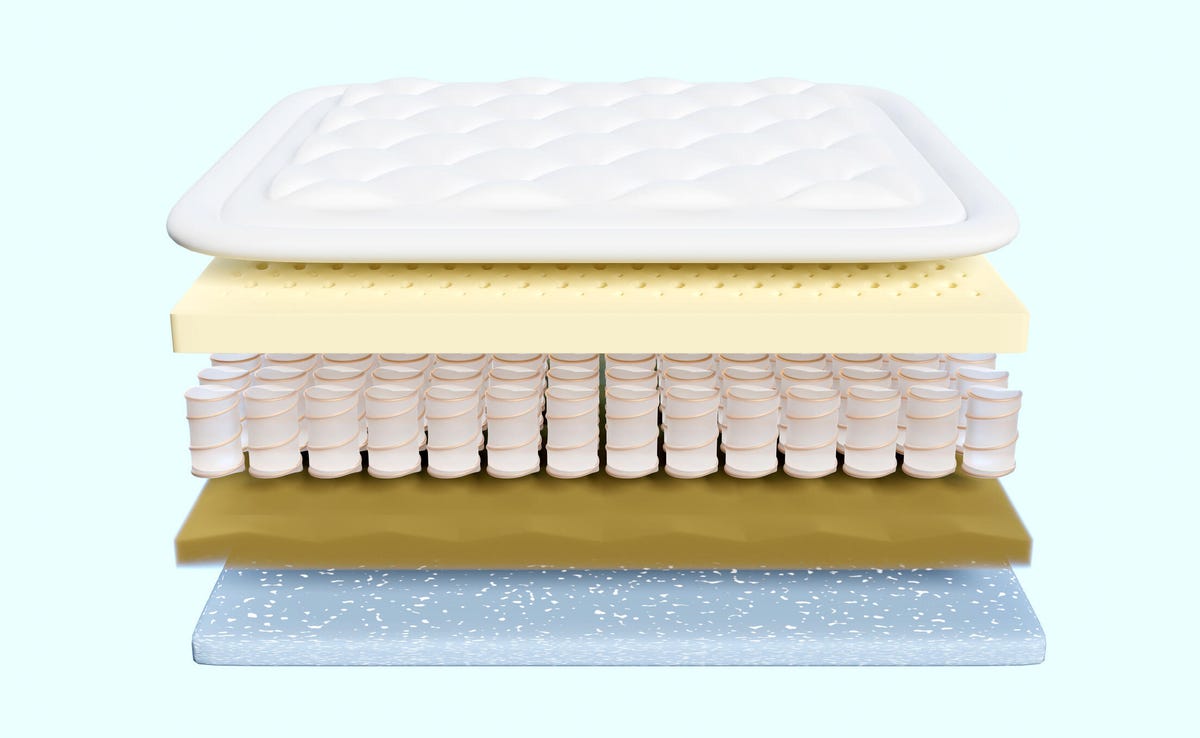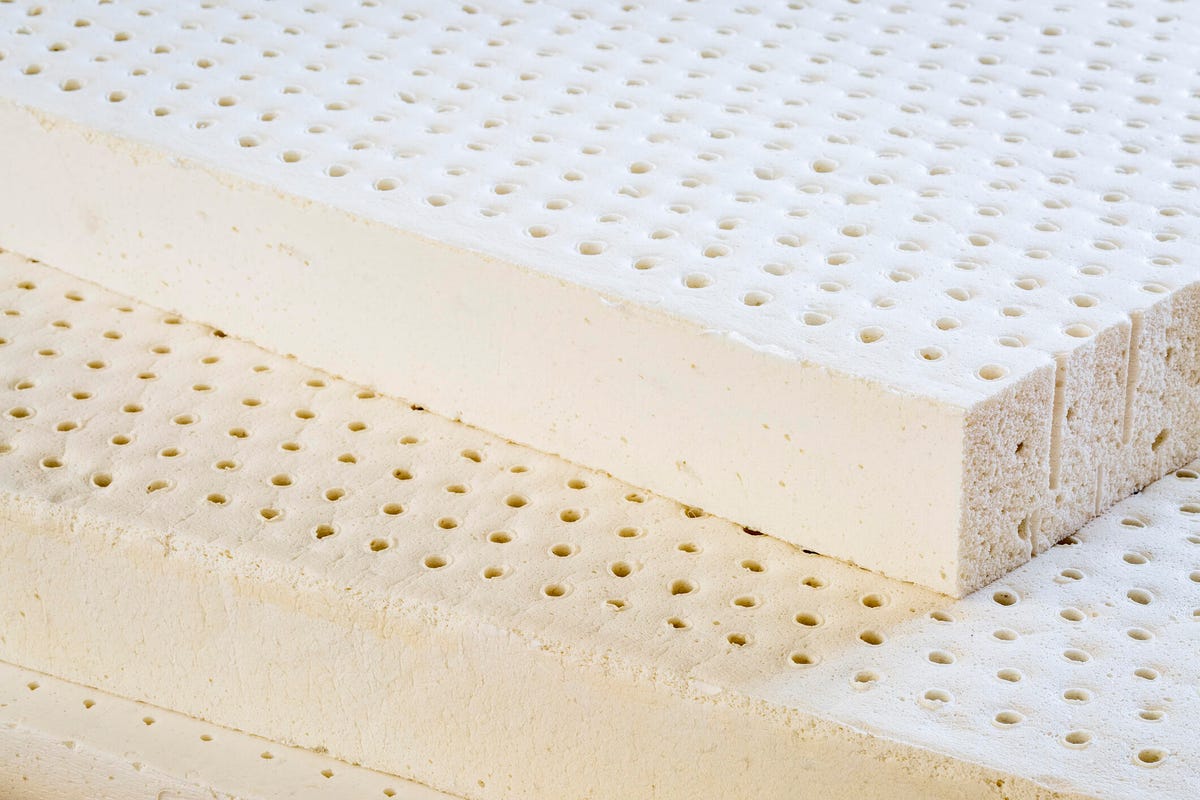How well you sleep can play a significant role in how the rest of your day and week goes. Sleep deprivation has been shown to cause or exacerbate several mental and physical health difficulties. With so much riding on how you sleep, it only makes sense to prioritize the right mattress for your best rest. Several key materials can impact how a mattress sleeps, whether considering innerspring, foam, hybrids or latex.
Read more: Best Mattress
What are the different mattress types?
Innerspring mattresses may still be what many imagine when thinking of a mattress. These types utilize coiled springs within the mattress to create supportive structure and responsiveness. Memory foam mattresses have become popular for their plush feel and ability to absorb more movement than other types. Latex mattresses offer a more balanced outcome, providing responsive support and comfort. Hybrid mattresses utilize a combination of these other materials to create different outcomes.
Innerspring mattress
Innerspring mattresses are not only the more traditional type but are also often more affordable than other styles of mattresses. These coil-based beds offer firm support and quick responsiveness to movement, making it easy to shift positions at night. That comes with the caveat that these mattresses tend to transfer motion more strongly than others. As a result, innerspring beds may be more disruptive for couples who don’t want to feel each other shifting at night.
Read more: Best Innerspring Mattress
Due to their coiled design, innerspring mattresses provide firm support. Larger sleepers or those who prefer a firmer bed may find that these mattresses help keep them from sinking or feeling unable to move comfortably. The firmness and durability of these beds can be strongly affected by how many coils are used in the design and how thick they are. The more coils and the wider they are, the firmer and more durable the mattress will likely be.

There are several pros and cons to consider when debating an innerspring mattress versus another type. On the upside, these mattresses offer good bounce and responsiveness, relatively high airflow and are generally more affordable than other types. Conversely, innerspring beds are also known for high motion transfer, considerable variability in durability and reduced comfort for some types of sleepers. Specifically, some sleepers have noted that these types of mattresses are worse at relieving pressure points than foam-based mattresses. For those who prefer plushness, innerspring can also present some discomfort.
Foam mattress
Foam mattresses predominantly utilize memory foam, polyfoam and gel-infused layers to create a variety of sleep experiences. Memory foam is often touted for its usefulness in comfort layers. This material molds nicely to the body, helping to relieve pressure points and allowing a person to sink into plushness. That can be particularly beneficial for individuals with certain types of joint or back pain. Polyfoam, another type of foam, is mainly used in support layers, where it can increase responsiveness and durability. Gel-infused materials are often used in conjunction with other types of foam to help keep the mattress cool.
Read more: Best Memory Foam Mattress
Foam mattresses are built by combining different layers of foam to achieve an optimal sleep sensation. These mattresses represent a great deal of variety and customization regarding how they sleep. The base layer is generally made from a high-density polyfoam, creating a strong support. Memory foam is predominantly utilized in the comfort layers, where it offers plushness and movement absorption. Foam mattresses may also incorporate gel-infused foam in some layers to help with heat dissipation. The gel infusion helps absorb and transfer heat, allowing the sleeping surface to cool more quickly.

The support within foam mattresses depends on the density and arrangement of foam layers. In general, the denser the foam, the more supportive and durable the mattress is. Couples often like these mattresses for their ability to isolate and reduce motion. How durable these mattresses are depends on the density of the foam used and the quality.
There are a few pros and cons to keep in mind regarding foam mattresses. Positive highlights are that these mattresses offer good pressure relief, high levels of motion isolation and highly customizable experiences. The negatives are that they often have higher heat retention, may off-gas a chemical odor at first and are higher in cost.
Hybrid mattresses
Hybrid mattresses combine innerspring and foam designs to create a unique sleep experience. These mattresses blend innerspring’s strong responsiveness with foam’s comfort and benefits. The comfort layers of foam offer cradling plushness and some movement isolation, while the innerspring serves as an underlying structure of bounce and responsiveness. The goal is a balance between plush comfort and a strong foundation that offers a perfect mix of sinking and ease of movement.
Read more: Best Hybrid Mattress
The innerspring coil system within these mattresses provides most of the support. While foam layers on top soften this some, hybrid mattresses offer a higher degree of support than pure foam mattresses, although less than a pure innerspring. How durable these mattresses are will depend primarily upon the number and strength of coils used and the quality and density of foam involved.

The pros and cons of these mattresses can be diverse, depending on the type and quality of the hybrid. These mattresses have a broader range of sleeper types they can serve, offer strong support layered in plush comfort and help some with heat reduction and motion isolation. Conversely, hybrid mattresses are often more expensive, and the combination of materials can result in heavier mattresses.
Because these mattresses are so customizable, it can be more important to know what you want in a mattress and what type of sleeper you are. Different hybrid beds come with varied designs suited for different kinds of sleepers.
Latex mattress
Latex can be derived from natural or synthetic sources, allowing for a range of purely natural mattresses to a combination of natural and artificial to a strictly synthetic latex mattress. People who prefer an environmentally focused product may find natural latex mattresses to be the boon they’ve been looking for. Still, it’s important to note that natural latex materials tend to cost more than synthetics. Natural latex is made from the sap of rubber trees, while synthetic latex is made from various petrochemicals.
Read more: Best Latex Mattress
Because of the unique material, latex mattresses can deliver high comfort and responsiveness. These mattresses are known for comforting body contouring without sacrificing responsiveness, thanks to latex’s inherent resiliency and elasticity. A latex mattress feels somewhat like the body molding of foam but without the sinking sensation. Since this material adapts and supports, it can provide comfort even for people who shift positions regularly in their sleep. This responsiveness may be less than an innerspring system but is much quicker than foam mattresses while still providing much of the comfort of a foam mattress.

Latex offers consistent support across the sleep surface and is well-known for its durability. These mattresses can be made with different firmness levels based on the density and structuring of the latex used. How firm it is will directly affect how supportive it is. Depending on the firmness used, these beds can be ideal for sleepers of different positions. Thanks to the durability of latex, these are often some of the longest-lasting types of mattresses.
Latex mattresses come with several pros and a couple of cons. They offer a natural material option, have high durability, provide a responsive sensation and can be hypoallergenic. The downside is that these mattresses tend to cost and weigh more than others.
How to choose the right mattress type
When looking for a new mattress, there are several factors to consider. Depending on your preferences and sleep style, one or more mattresses may suit you.
Comfort
It’s vital to understand your comfort preferences and consider that. Mattresses can range from very firm and not plush to very plush with a strong sinking feeling. Where your comfort zone lies on that spectrum can help inform what type of mattress could be best for you.
Support
Support can play into comfort, as well. How supportive a mattress is significantly impacts what it feels like when sleeping. If you have specific joints that tend to ache, you may want to consider that when determining support. For instance, people with regularly sore backs may want a mattress with strong spinal support.
Durability
The durability of your mattress will determine how long it lasts. If you don’t mind replacing your mattress regularly, this factor may not be as important. Durability tends to go up with cost, so if budget is a primary concern, durability may be less of one.
Heat dissipation
How hot you sleep can be another critical factor to know about yourself and your preferences. Hot sleepers can benefit from mattresses with better airflow or cooling properties. Examples would be the increased airflow of innerspring mattresses or the heat dissipation advantages of gel foam.
Motion isolation
Couples often prefer mattresses with higher degrees of motion isolation. That reduces how much you feel each other moving in the night through the mattress. Foam mattresses tend to offer higher degrees of motion isolation.
Budget
Finally, budget is a crucial consideration for most mattress shoppers. Innerspring mattresses are the most affordable, followed by foam mattresses and latex.
Other types of mattresses
Air beds: These inflatable mattresses are convenient because they can be folded up and stored when not in use. They are lightweight and affordable and can be ideal for camping or hosting an unexpected guest. Although their comfort and support are limited, they can more than make up for that with convenience.
Water beds: Water beds have water-filled chambers that offer a unique sleep sensation. These beds allow you to sink, potentially more than memory foam, and provide a high level of motion isolation, making them suitable for couples. They tend to be low on convenience and high in cost, however.
Adjustable beds: Generally electronic, these days, adjustable beds can have the head and foot locations shifted to be at different heights and angles. These can be useful for creating unique sleeping positions to help with physical discomforts or other issues like snoring and acid reflux.
Pillowtop beds: These mattresses can be represented in most types of beds already discussed. What makes this type is the addition of padding sewn onto the mattress, creating a plush and comfortable surface. The added comfort layer is often made from foam.

